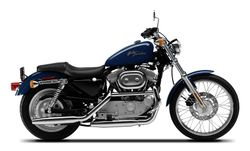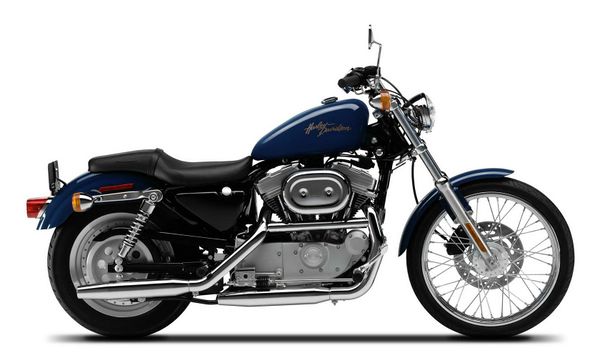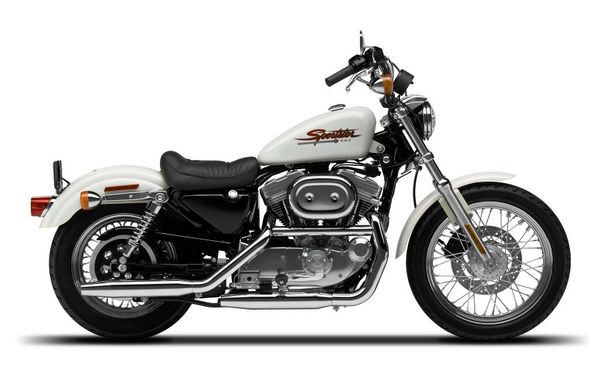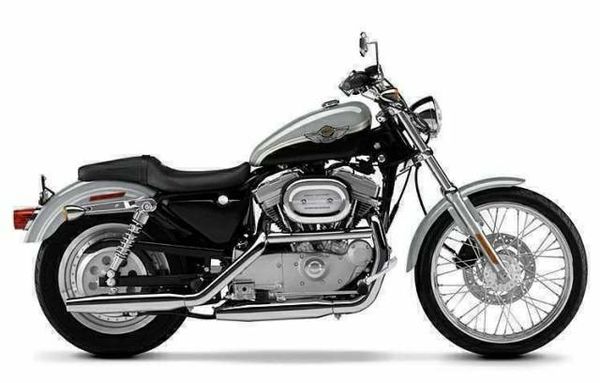Harley-Davidson XL53C Custom
 |
|
| Harley-Davidson XL53C Custom | |
| Manufacturer | |
|---|---|
| Production | 1998 - 03 |
| Engine | Four stroke, 45° V-Twin, OHV, 2 valves per cylinder |
| Compression ratio | 8.8:1 |
| Ignition | Inductive, battery-powered,V Fire III electronic breakerless with solid-state dual stage advance |
| Transmission | 5 Speed |
| Frame | Mild steel twin cradle |
| Suspension | Front: 35mm Showa telescopic forks. Rear: Dual shocks with adjustable damping |
| Brakes | Front: Single 292mm disc 2 piston calipers Rear: Single 292mm disc 1 piston calipers |
| Front Tire | 80/90-19 |
| Rear Tire | 130/90-16 |
| Wheelbase | 1510 mm / 59.4 in |
| Seat Height | 700 mm / 27.6 in |
| Weight | 245.0 kg / 540.1 lbs (dry), |
| Fuel Capacity | 12.5 Liters / 3.3 US gal |
| Manuals | Service Manual |
Engine[edit | edit source]
The engine was a Air cooled cooled Four stroke, 45° V-Twin, OHV, 2 valves per cylinder. The engine featured a 8.8:1 compression ratio.
Chassis[edit | edit source]
It came with a 80/90-19 front tire and a 130/90-16 rear tire. Stopping was achieved via Single 292mm disc 2 piston calipers in the front and a Single 292mm disc 1 piston calipers in the rear. The front suspension was a 35mm Showa telescopic forks. while the rear was equipped with a Dual shocks with adjustable damping. The XL53C Custom was fitted with a 12.5 Liters / 3.3 US gal fuel tank. The bike weighed just 245.0 kg / 540.1 lbs. The wheelbase was 1510 mm / 59.4 in long.
Photos[edit | edit source]
Overview[edit | edit source]
Harley Davidson
XL 53C Sportster Cuustom
The Sportster custom was never on my list of priority bike to test because it failed at every hurdle for me.
Firstly it was a Sportster. Secondly it was a Sportster that was trying not to be a Sportster. Lastly it was an 883 Sportster. Oh dear.
I can forgive Sportsters usually because at least they are pure in spirit, even if I dont actually think Ill ever park one in my shed for anything other than road-testing purposes, but as soon as one tries to be something its not oh dear, oh dear.
Still, it needed doing not least because the Stage One 883 wed had out the previous week was not happy and we needed confirmation of that. That the only other 883 available was a bog-standard 53C did nothing to improve my mood, but the sun was out and youve got to take the rough with the smooth.
Id given the XLH883 one last chance to come good on the run down from South Cheshire to Northampton but apart from an increasing certainty that it was set up badly, somewhere down the line, it didnt. I handed it over, muttering something about checking the timing, at least, and went out to give the 53C the once-over.
No chance of being inconspicuous, was my first reaction on sight of the pearl white baby custom, but I did look at it properly for the first time. Solid rear wheel from the parts bin, twenty-one inch front wheel from the same source. The bastard offspring of a Night Train and an 883 was the immediate thought: shame it wasnt black, we could do something with that in the features title. I slung the throw-overs across the saddle and thumbed the starter, straining to hear the noise from the silencers and remarking on the lack of top end squeaking that had typified my miles with the Stage One 883. Sufficiently warm for a clean pull away, we rejoined the A5 traffic heading back North and I finished warming the diminutive bike before giving it chance to redeem its family name.
By the time wed cleared the traffic from resurfacing roadworks outside Wayside, the motor was good and warm, and ready to roll so it was time to lay the spectre to rest. I wasnt surprised to find it revved as well as it did, because Id been disappointed that the 883 didnt. This was more like it: a stifled, but happy little revver that didnt amaze with its gutsy deep down power in the way that a big twin would, or even quick responsive revving power beloved of its bigger 1200cc sibling, but it wasnt especially stressed, and it didnt become uncomfortably vibrant.
The shorter shocks, shared with the Hugger, meant that the tarmac was always closer than it had been on the stock model, but the frame was the same, and as stiff as both it, and the 1200S demanded: the lower seat height of both the 53C and the Hugger take their toll of the cornering clearance but it still ranks up there with the sportier Dynas - courtesy of extra long shocks - and the surprising Deuce which gets its extra from the low-profile rear tire. I never ran out of clearance on either side, it has to be said, or at least not in a way that sticks in my mind, but then as a rider of big twins, Im used to the sound of scraping metal, and only at the point where the frame touches down is it time to look for a hole in the hedge. Until that point arrives, the weight is more than up to the job of keeping the wheels in contact with terra-firma. On any Sportster, the frame is tucked so far in that the engine cases will touch down first, and if that happens, youll be on your side. What would touch down on the 53C would be the side-stand and the exhaust brackets.
The confidence-inspiring cornering and revvier motor knocked back any concerns regarding the oversteer of the 883, but then corners were arriving more quickly, and the weight and balance of the steering were well suited to the role. It still required something of a run-up to overtake traffic comfortably, but that was now traffic travelling close to the speed limit rather than agricultural machinery that had strayed onto the highway.
Just as the tight chassis inspired confidence, so too did the brakes, being the twin-pot items fitted to everything nowadays - a single front and rear - were more than up to the job, as indeed is the same combination on a surprising number of big twin models.
This was the bike I expected the XLH883 to be and I was glad to have buried the experience of the poorly set-up example. What I really want to know now is how the Stage One should have felt, because this was showing real potential.
I bimbled around for a week on the 53C before handing it to Rich, taking every opportunity to hack around on it: exorcising the ghost of recent memories, and found it to be both practical and pleasant in a variety of roles - although I didnt venture onto a motorway with it: that wouldve been asking too much. I dont think Id be too keen to cover more than fifty miles at a stretch voluntarily, although was obliged to more than double that at least once. At its worst - notably after a hundred and fifteen miles - I found that it was still more comfortable than the Night Train with which it shares a large number of components, but thats condemning it with faint praise.
I still wouldnt actively seek a Sportster for distance work because there are so many better bikes without leaving the Harley stable, and Id be happy to pay the higher price, but for all that the little custom grew on me immeasurably during that week, which was something I noticed when I finally knelt down with my camera to photograph it. There were so many bits that were right, and made for quite a looker in a strange sort of way. The solid rear wheel didnt look as overpowering as it shouldve done, and the tall skinny wheel up front was quite well at home in the upright forks that contrasted markedly with such a hoops normal resting place. The chrome shroud round the risers, that serves to hide the wiring for the idiot lights and provide a platform for the speedo, became more attractive with familiarity, not least because the almost flat bars set it off so well, and the deep-dish headlamp shell is a favourite of mine in custom applications and finished off the front end in grand style.
Slightly more Heath-Robinson were the rods that linked the control levers to their original locations: heavy and not especially pretty, and something akin to that which Id have made, but much more likely to survive long term use and not at all delicate. Hardly a criticism, because Id far rather it worked.
The only regrets are that we didnt have the 1200C alongside to compare and contrast the feel of the engines one after the other - which is the only way to make an objective observation - and indeed that the original XLH883 with Stage One kit was so bad, because Id love to know how much difference to the engine the free breathing carb and pipes made.
Still, all-in-all, and despite earlier misgivings, the 53C lives in my memory as the Sportster that I could imagine owning but not in white, and only if I didnt need a bike to do any serious distances on.
Second Opinion: Words: Rich
Back in 1998 Harley-Davidson launched two new models into the European theatre, designed to appeal much more to European taste than to their home market. One of those models was of course the mean black Softail dubbed the Night Train, which so astonished the public that the other model launched as its Euro-specific stablemate was very much left in its shadow. That model was the XL53C Sportster Custom 53, a mealy mouthful that is now more usually referred to as the 53C.
Though overshadowed by its bigger companion, in no way would I like to infer that the 53C has in any way been a failure. There are a lot of them about - in Britain at least - and its not too difficult to understand why: the 53C is a handsome piece of kit. An 883cc, it asks an extra £800 over the price of the base model, making it the most expensive baby Sportster in 2001, but that extra money offers a much higher level of trim. With forward-set front pegs, unmistakable solid rear wheel, that single riser tower gripping the fairly flat bars and a sleek gunfighter type seat, the 53C does cut a dash. But whether Harley-Davidson caught the European taste with this machine as they so obviously managed with the Night Train is definitely debatable. Had the 53C been offered just in black, as the Night Train initially was, with perhaps a lot less rear mudguard Idve said a reserved yes. However Id also argue that the new sportier looking 883R is closer to tapping into that ephemeral European ethic when it comes to smaller neater machines like Harleys Sportster range.
Nevertheless, the 53C feels much more of a finished concept than its cheaper brothers, the XLH & Hugger 883s, both of which offer a better blank canvas for potential owner modification. If the 53C floats your boat, then a stage one or two on the motor and thats about it, Bobs your Auntie. If the 53C doesnt float your boat, then there is absolutely no point in buying one, get a plain old XL and your extra £800 is better spent on taking it the direction you personally want your Sportster to go.
Out on the street the53C doesnt feel quite so nimble as the XL883 and I missed the surefooted wider tire on the 19inch front wheel. The 53Cs skinnier tire on the laced 21-inch looks the part, if you like that sort of thing, but Im more of your chunky kind of guy. The narrow drag bars sat high above the top yoke worked okay out of town, but werent really quite so suited to town work. Making the rider have to work much harder to physically steer the machine through the traffic. Which is a problem, because the 53C isnt really at home out in the sticks either, although the motor has long enough legs of course, the rider will soon start to suffer, despite the cruise height bars.
A possible improvement over the 1998 53C though is at least the instrument console on this particular bike didnt clout the petrol tank on full lock as the one I tested in 98 did.
With such a minimal seat and fairly stiff rear low suspension the ride is quite uncompromising, much like any other Sporty, except a Sportster rider can normally compensate somewhat by moving around a bit, taking the weight off their bum. This is by reason of the siting of their front pegs, which although not right underneath the rider, still allows the rider to transfer some of their weight through their feet. No such luck with the 53C: legs out in front, youre stuck there and thats that. That the cruising-style forward sets should actually inhibit comfortable long distance cruising is bonkers - and smacks of style before useful function.
Best not mention the pillion perch - for perch it is, and should only be considered for emergencies.
Handling is okay, the frame is still a Sportster after all and is a stable, stiff and secure platform. But again that ability to handle is marred. Whereas an ordinary XL883 Sportster allows at least some vigourous bend taking before grinding out, the 53C grinds out all too soon, losing a full two degrees of lean on the left and a staggering 5 degrees on the right! That makes this fairly little bike almost as ungainly as your average Big Twin.
Theres nothing wrong with either the front or rear brakes, they work just fine and not really all that surprising given that Harley fit just those same two stoppers to many of their larger bikes too. The stock 883 motor is underpowered anyway so the brakes are hardly likely to tested to their limit - but even with a hint of breathing on, in the shape of a stage one or two conversion, the brakes should still be more than adequate.
That the engine is so under-utilised is a shame, but inevitable given the unfair constraints imposed on it by various environment agencies. Luckily much of that potential can be legally released once purchase has been made, but even so, that the owner should be asked to cough up another £500 at least on top of that purchase price to get to it doesnt really seem all that fair. Having said that of course, its a distinct possibility that many 53C owners dont bother to release any more power from the motor! After all, what would be the point if the 53C, set up as it is, doesnt really allow you to get the best out of all that extra oomph anyway?
All in all, the XL 53C ends up being a bit of a dogs dinner, not quite fulfilling any of the tasks it is asked to handle. It is a nice looking machine, no doubt about it and the finish is excellent, but its a distinctly uncomfortable long distance machine; doesnt really cut it on mid-distance country road ride-outs and is too harshly suspended, the bars arent quite right and its too slow turning for really useful town work. Its as a High Street bar-hopper that the 53C really cuts it, a head turning style statement. But whether that is enough use in itself to justify actually buying one is another question entirely
Source
| Make Model | Harley Davidson XL 53C Sportster Cuustom |
|---|---|
| Year | 1998 - 03 |
| Engine Type | Four stroke, 45° V-Twin, OHV, 2 valves per cylinder |
| Displacement | 883 cc / 53.8 cu-in |
| Bore X Stroke | 76.2 x 96.8 mm |
| Cooling System | Air cooled |
| Compression | 8.8:1 |
| Lubrication | Dry sump, gear drive pump with full flow spin-on disposable oil filter |
| Induction | Carburettor, 40 mm constant velocity with enrichener and accelerator pump |
| Ignition | Inductive, battery-powered,V Fire III electronic breakerless with solid-state dual stage advance |
| Starting | Electric |
| Max Power | 53 hp / 38.6 kW @ 6000 rpm |
| Max Torque | 67 Nm / 49.4 lb-ft @ 4100 rpm |
| Transmission | 5 Speed |
| Final Drive | Belt |
| Gear Ratio | 1st 9.717 2nd 6.690 3rd 5.180 4th 4.267 5th 3.615P |
| Frame | Mild steel twin cradle |
| Front Suspension | 35mm Showa telescopic forks. |
| Rear Suspension | Dual shocks with adjustable damping |
| Front Brakes | Single 292mm disc 2 piston calipers |
| Rear Brakes | Single 292mm disc 1 piston calipers |
| Front Tire | 80/90-19 |
| Rear Tire | 130/90-16 |
| Dimensions | Length 2245 mm / 88.4 in |
| Wheelbase | 1510 mm / 59.4 in |
| Seat Height | 700 mm / 27.6 in |
| Ground Clearance | 159 mm / 6.3 in |
| Dry Weight | 245.0 kg / 540.1 lbs |
| Fuel Capacity | 12.5 Liters / 3.3 US gal |


